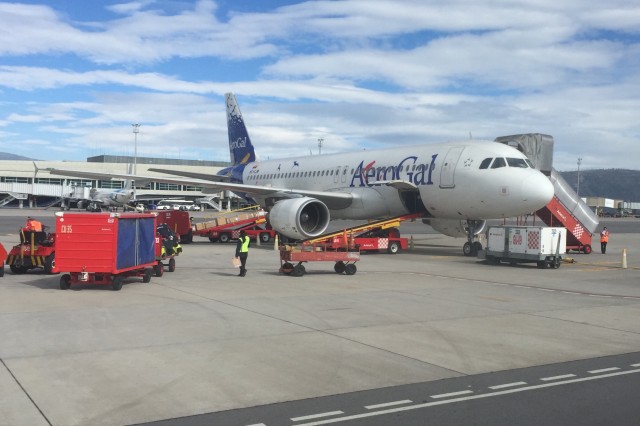
HC-CJM, a 2010-built A320-214, still in the Aerogal livery on the ramp at SEQM – Photo: Bernie Leighton | AirlineReporter
Recently, I found myself in Ecuador to go experience endemism in person. If you are not biologically inclined, I am referring to going to the Galapagos archipelago in the Galapagos Province of Ecuador.
I flew into Quito on American Airlines, but because I was part of a group, I was given no choice, or information, on how we were getting to Puerto Baquero Moreno (SCY). If it had been up to me, I’d have flown LAN Ecuador. After all, I am Oneworld Emerald and would’ve loved priority baggage, boarding, lounge access, and whatever else LAN offers Emeralds. Thing is, it wasn’t up to me. We were to fly Avianca Ecuador, operated by Aerogal, not even with seat selection.
Having done my research and spoken to as many frequent-flying locals as I could, I had heard that LAN was head-and-shoulders above both (quasi government owned) TAMà‰ and Avianca. Downcast, but excited to visit islands that cause tons of theological contention, I made my way to Mariscal Sucre Airport in Quito with a quiet sense of sadness.
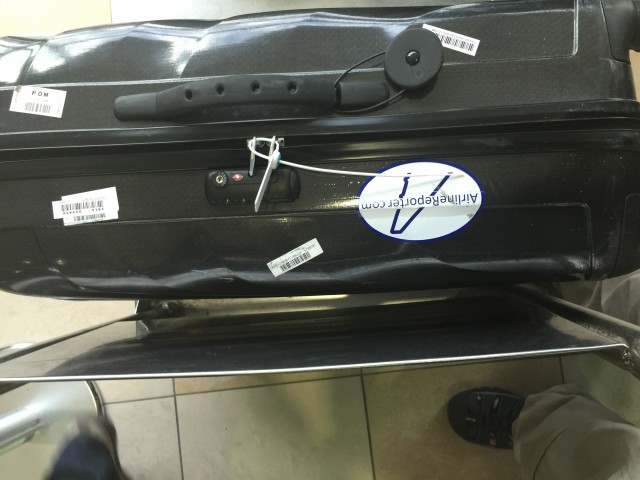
Checked luggage heading to the Galapagos is zip-tied shut to prevent smuggling – Photo: Bernie Leighton | AirlineReporter
It is now that I must deviate from the flight review to explain how one actually flies into Galapagos National Park. One does not simply check in at the desk and land at San Cristobal or Seymour as a normal domestic flight. Nope.
First you must fill in paperwork from the ministry of agriculture, then you have your luggage (and carry-ons) x-rayed for contraband. Not only does contraband include the standard list of things banned from aircraft, it also has the most extreme agricultural controls I have ever seen. After that, your checked luggage is zip tied shut. Why? Because there was a scandal a few years ago where some miscreants were inserting large amounts of narcotics into passenger baggage to sell within the Galapagos at a ridiculous markup.
Security in Mariscal Sucre Airport is how all security should be. It’s precheck without waiting for three beeps. Things are a little different flying internationally, of course. Either way, I was through security in five minutes – even without a priority line.
The domestic departures area of Mariscal Sucre is spartan. The airport, overall, is beautifully generic. There is no identifying architectural characteristic to tell you you are in Quito. It is optimized for passenger throughput and retail. More airports need to be like that. Regardless, I am not even sure if there was a lounge. All I could find was a rather ominous-looking restaurant calling itself the bilingual Guacamole Cafe. Hungry, but concerned for my gastrointestinal health, I abstained.
It was at that point I noticed a concerning note on my boarding pass “Grupo C”. Ah, zone boarding — my arch nemesis. Imaginary points off the airline were deducted immediately. I was also perplexed because it said in the contract of carriage that they would make every possible effort to make sure photography equipment traveled in the cabin. Being in Zone 3 and seat 24K didn’t exactly spell empty overhead bins in my future.
After waiting about forty minutes in the sterile (in all senses of the word) departure lounge, it was time to head to the bus. I was worried, for a moment, that we’d have a jetbridge with enforced zones. They enforced the zones for a bus, but once on the bus the rules are different. It’s every person for themselves.
Bite, claw, scratch, punch. Doesn’t matter. Get off the bus ASAP and get that bin space. Except… no one in Ecuador other than the tourists travels with hand baggage. Crisis two: averted.
It gets better.
What if I told you that when I walked in the cabin, rather than seeing B/E Aerospace Super Slimlines, Recaro’s new ass-savagers (I think that’s actually their name), I saw civilized, Weber LONG-HAUL economy class seats.
Guess the seat pitch? I bet you said 30″. It’s okay, I thought it’d be 29″. It was 34″! Seriously 34″, which is only two inches less than Alaska Airlines’ first class.
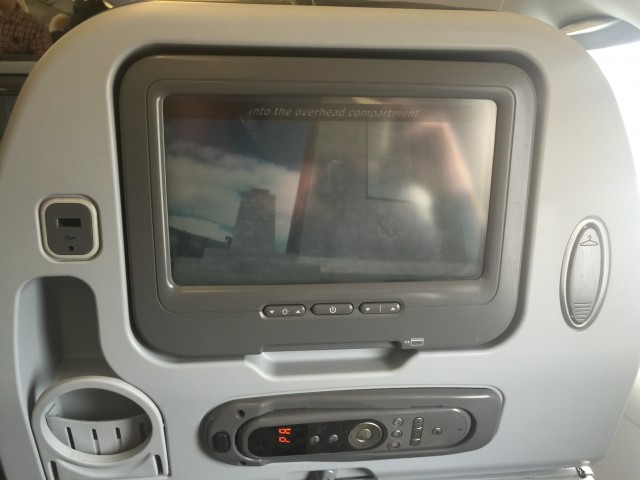
Even on a 35-minute flight, all IFE options are available – Photo: Bernie Leighton | AirlineReporter
I was blown away. Then I looked at the seat backs. Not only did they feature 5V USB power, a cupholder, and a coat hook, but they had in-flight entertainment (IFE). It was of the Panasonic EX series. Looking at the controller, it looked like an earlier model, but still full AVOD. Not even pay-per-view or spartan in content.
Oh, I forgot to mention how long the flight was; 35 minutes to Guayaquil, 40-minute ground stop, and then an hour-and-a-half to Puerto Moreno.
So yes, full long-haul economy experience on a flight that was only a little over two-and-a-half-hours.
As I boarded, I noticed that the APU was screaming. Another positive. Even 8,000 feet off the ground, Quito is extremely equatorial. It’s bloody hot. So having the AC packs going full blast costs money, but really improves the passenger experience.
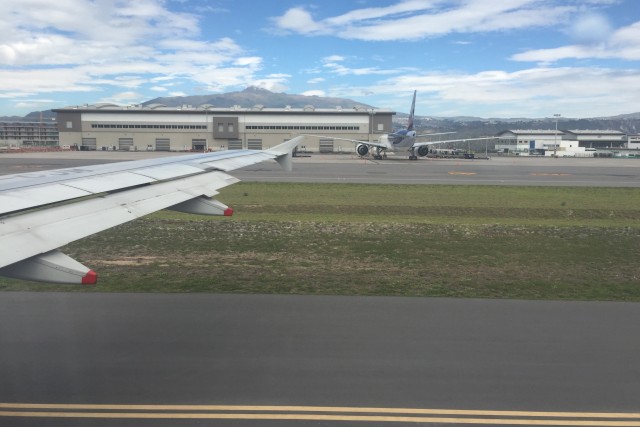
Taxiing past a LAN Cargo 77F at Mariscal Sucre International Airport. Photo – Bernie Leighton| AirlineReporter
Once we were all seated, it was time for the safety video. It was presented twice. Once in Spanish, once in English. It was well produced and informative.
Pushback was docile, as was taxi to the runway.
After that, it was time to discover why Mariscal Sucre’s runway is 13,451 feet long. Quito to Guayaquil is 176 miles per GCmap; 35-minute flight. With all that, the pilot flying stood on the brakes, put the throttles to 100% N1 and held it. After 43:25 seconds, we were in an oddly-slow climb.
Oh well, not to worry. I had Game of Thrones to watch!
Plugged into the seatback IFE, I didnt’ even notice that four flight attendants were working the cabin from two carts. For a 35-minute flight, not only were we given a full drink service, but there was also a muffin. Not a rock-hard, offensive, muffin. But a stalwart and tasty chocolate and vanilla one.
I imagine business class was given a full sandwich.
I was seriously impressed.
Even as the crew were collecting the refuse, we were descending. Over the rice paddies of the area surrounding the Guayas river and into Guayaquil’s slightly-older new airport.
On the ground, we were not allowed to depart the plane. I understand why; 40 minutes is not long enough to corral the passengers and keep them from going too far away from the gate, causing delays. What I did not understand was the byzantine stance on electronics and lav use during refueling. Not even kindles were, technically, allowed.
The aircraft was also double catered. There are no services other than loading and unloading available at San Cristobal airport. Not even reliable fueling.
Even with all that, a second round of safety videos, and the cabin fogging from the AC packs sucking that much humidity out of the air, my enthusiasm was not curbed. We taxied to runway 03 (only 9,154 feet long) and were airborne for our 678-mile flight to SCY in 35:45 seconds. Recall, however, that Guayaquil airport is only 19 feet above sea level.
I returned to Westeros.
Only to be interrupted by a friendly flight attendant offering me food. Yes a, free, hot meal on a flight. Was it substantial? Sort of.
Look. My expectations for economy food are so low that I thought it’d be terrible. It was actually good. It was a chicken and farmer’s cheese sandwich. Very Ecuadorian. I guarantee you that business class got tray-service.
After that, it was another hour of flying over empty blue.
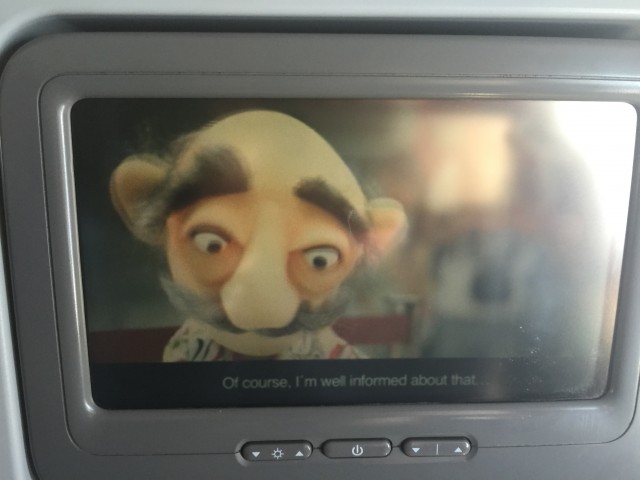
Somehow, a puppet named Nathan Jones speaks better Spanish than me – Photo: Bernie Leighton | AirlineReporter
Until, my IFE cut out. It was replaced with puppets. A puppet named Nathan Jones who spoke terrible Spanish. What was he doing? Talking to another puppet, of course. Now, this was supposed to be taking place in Seymour airport, except I could see the Mariscal Sucre offices in the background. Ow, my verisimilitude. Anyway, he was talking to another puppet – a Galapagos guide- telling him what he could and could not do on the islands.
We landed in an epic monsoon. Unfortunate, as by the time I was able to exit the plane via the rear door, the ground crew had run out of umbrellas. All that was left was to clear Galapagos agricultural control and begin my adventure.
Overall, I am very impressed with what was once a (much maligned) Ecuadorian airline.
South America’s market is way more consolidated than North America’s, yet because they lack Wall Street’s bizarre unit cost fetish, they can get away with lovely cabins and great service.
It’s truly a civilized experience.
One more thing; apologies for the photos. Originally I had not intended to write an article, since I did not feel there would be a story, so I left my SLRs in the overhead bin.
Comments are closed here.
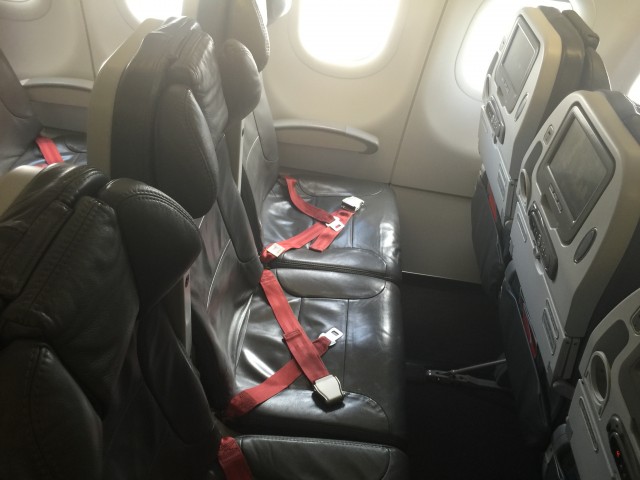
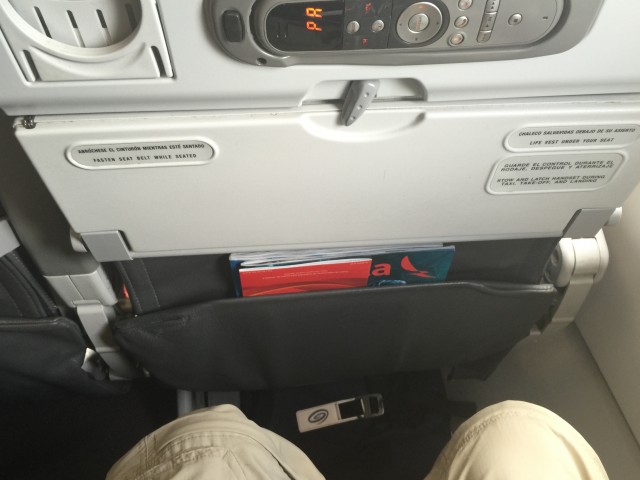
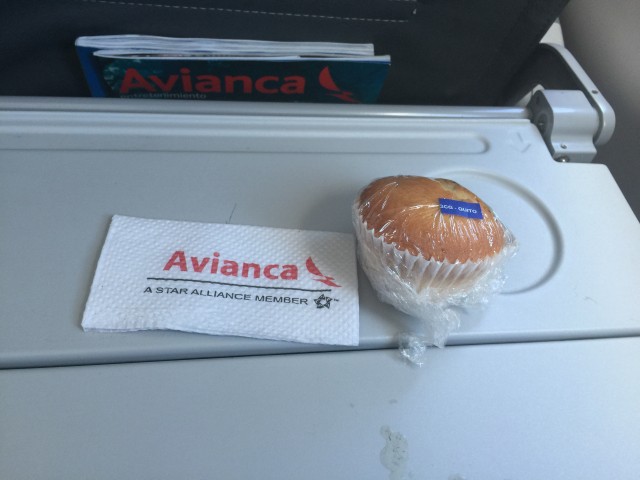
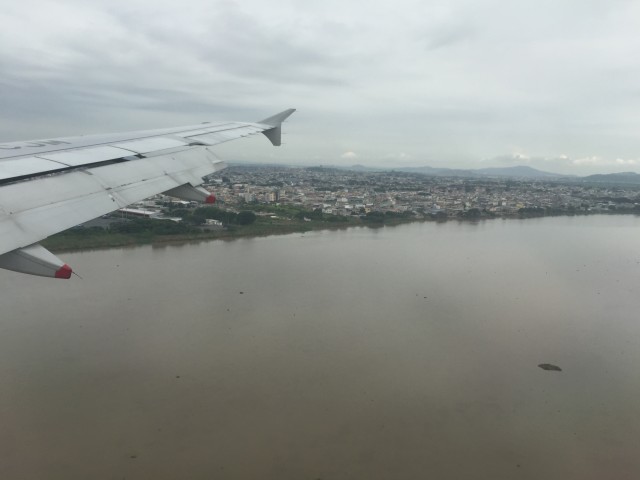
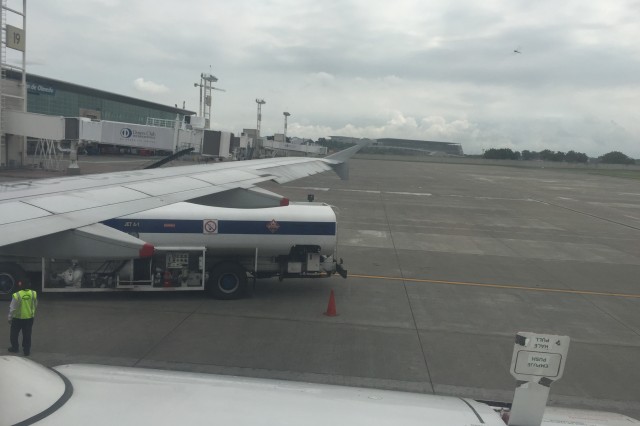
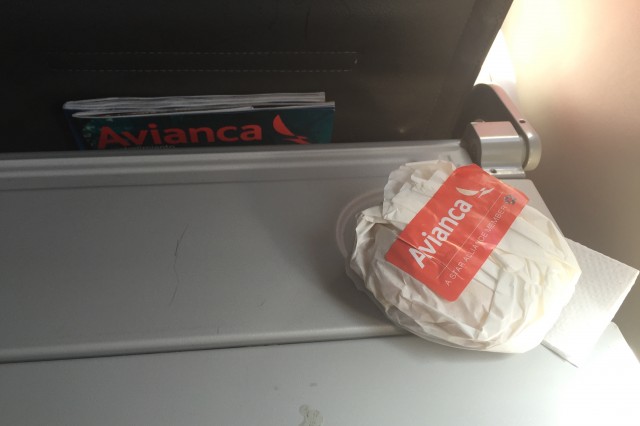
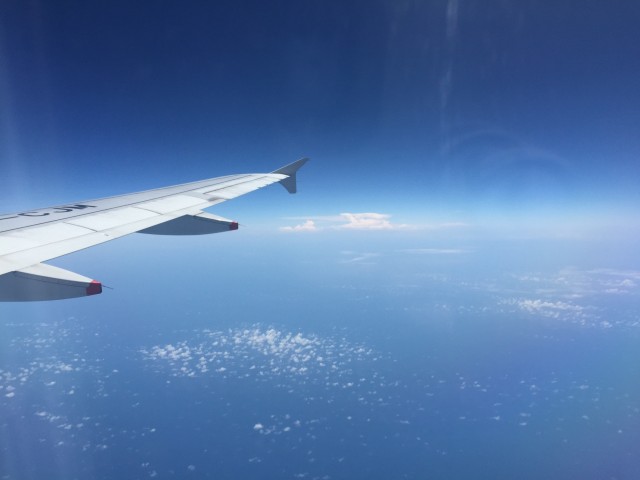
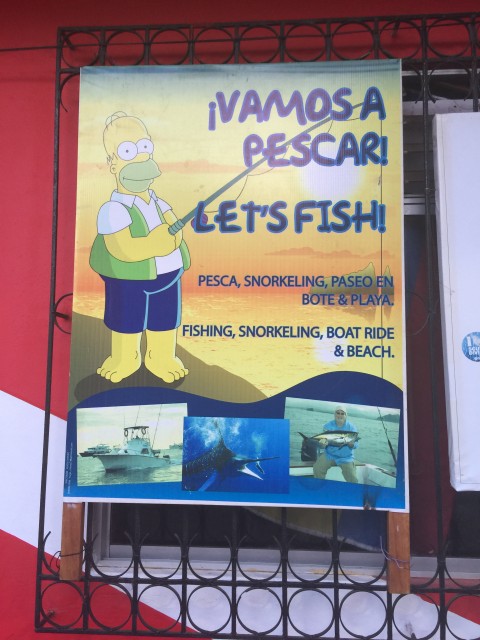
Well written and entertaining as always. I’ve long wanted to check out AeroGal, glad to see at least the livery is still in tact, for now.
The food court at the new Quito airport is not in the terminal, it is across the street in the parking structure. My favorite venue there is the Noe sushi bar. The 2 or 3 restaurants in the terminal are much more expensive than those in the food court.
Thank you, sir!